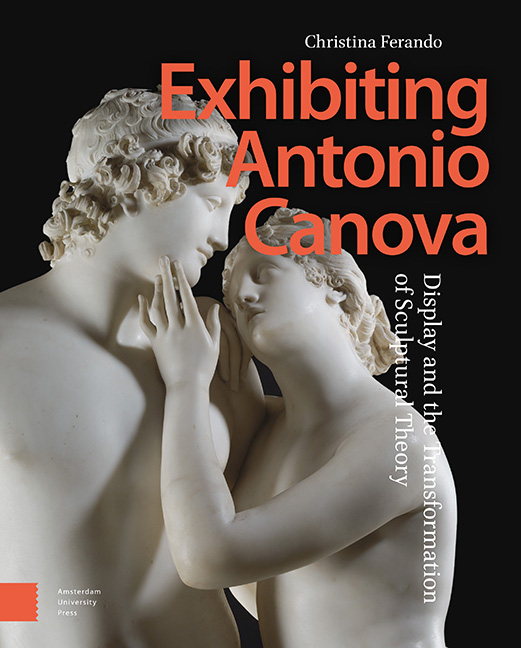Book contents
- Frontmatter
- Table of Contents
- List of Illustrations
- Acknowledgements
- Introduction: Canova on Display
- 1 Imagining Sculptural Practice
- 2 Reevaluating Ancients and Moderns
- 3 Anatomizing the Female Nude
- 4 Challenging the Supremacy of Painting
- 5 Defining Modern Sculpture
- Conclusion: Aftereffects
- Bibliography
- Index
1 - Imagining Sculptural Practice
Published online by Cambridge University Press: 13 February 2024
- Frontmatter
- Table of Contents
- List of Illustrations
- Acknowledgements
- Introduction: Canova on Display
- 1 Imagining Sculptural Practice
- 2 Reevaluating Ancients and Moderns
- 3 Anatomizing the Female Nude
- 4 Challenging the Supremacy of Painting
- 5 Defining Modern Sculpture
- Conclusion: Aftereffects
- Bibliography
- Index
Summary
Abstract: Chapter one, “Imagining Sculptural Practice,” centers on the 1795 exhibition of Canova’s Venus and Adonis in Naples. The sculpture was displayed in a small temple in the garden of Francesco Maria Berio, Marchese di Salza, and the group launched a citywide debate regarding modes of artistic production. Using Canova’s statue as a jumping off point, writers imagined Canova’s working process in detail, from its conceptual origins (“invenzione” or “invention”) to the final carving of the piece (“esecuzione,” or “execution”). Critics not only argued about Canova’s approach to the act of sculpting, but, more importantly, about how best to describe and communicate the sculptor’s process to a broad audience.
Keywords: sculptural production, invention, execution, Naples, Venus and Adonis, ekphrasis
By 1795, when Canova’s Venus and Adonis was unveiled in Naples in the garden of the Palazzo Berio, Canova’s reputation was well established. He had already been a fixture in Rome since 1781, when he opened his first studio in the city center, and his Theseus and the Minotaur, of the following year, was said to have ushered in a new style of art. Prominent papal commissions, such as the funerary monument to Clement XIV in Santa Apostoli in Rome (1783–1787) and the recently completed monument to Clement XIII in St. Peter’s (1792) further enhanced his reputation. Yet Venus and Adonis was one of the first significant, independent, secular groups Canova made for a private patron that was exhibited to great public acclaim. The sculpture received the expected éclat and then some, for Naples’ role as a destination on the Grand Tour and the sculpture’s evocative setting in the garden of a prominent nobleman’s palazzo attracted tourists from all over the continent. Interest in the sculpture was further heightened by a debate about the sculpture’s creation that raged in the Neapolitan press for well over a year. In what follows, I trace the way this nexus of viewing, reading, and writing about art allowed beholders to grapple with the question of what constituted the creative process—particularly with regards to sculptural production—at the end of the eighteenth century.
- Type
- Chapter
- Information
- Exhibiting Antonio CanovaDisplay and the Transformation of Sculptural Theory, pp. 43 - 82Publisher: Amsterdam University PressPrint publication year: 2023



